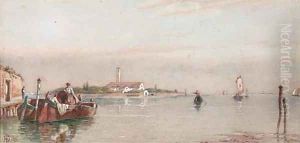James Herve D'Egville Paintings
James Hervé D'Egville was a prominent figure in the world of dance and choreography, whose career spanned the late 18th and early 19th centuries. Born in 1770, D'Egville came from a lineage deeply rooted in the arts; his family was notably involved in dance, which undoubtedly influenced his career path from an early age. Though specific details about his early life and training are somewhat sparse, it is clear that D'Egville was part of the wave of artists who thrived during a period of significant cultural and artistic transitions in Europe.
D'Egville's career is particularly noted for his work in England, where he became a significant figure in the ballet and dance scene. He took on the role of master and choreographer at the King's Theatre in London, a position that placed him at the heart of the city's cultural life. His work there, and at other venues, showcased his ability to blend classical ballet techniques with the evolving tastes of contemporary audiences, making ballet accessible and appealing to a broader demographic.
Throughout his career, D'Egville was known for his innovative choreography and his ability to train dancers who would go on to have significant careers of their own. His contributions to ballet and dance included not only performances and productions but also pedagogical efforts, helping to shape the next generation of dancers and choreographers. Despite the challenges of the era, including political upheavals and changing artistic tastes, D'Egville managed to maintain a reputable and influential position in the arts community.
James Hervé D'Egville's death in 1836 marked the end of an era in British ballet and dance. His legacy, however, continues to be felt, as his stylistic innovations and teaching methods have been passed down through generations. While not as widely recognized today as some of his contemporaries, D'Egville's impact on the development of dance in England and his contributions to the arts more broadly cannot be understated. His work bridged the gap between classical and modern forms of ballet, setting the stage for future developments in the art form.
